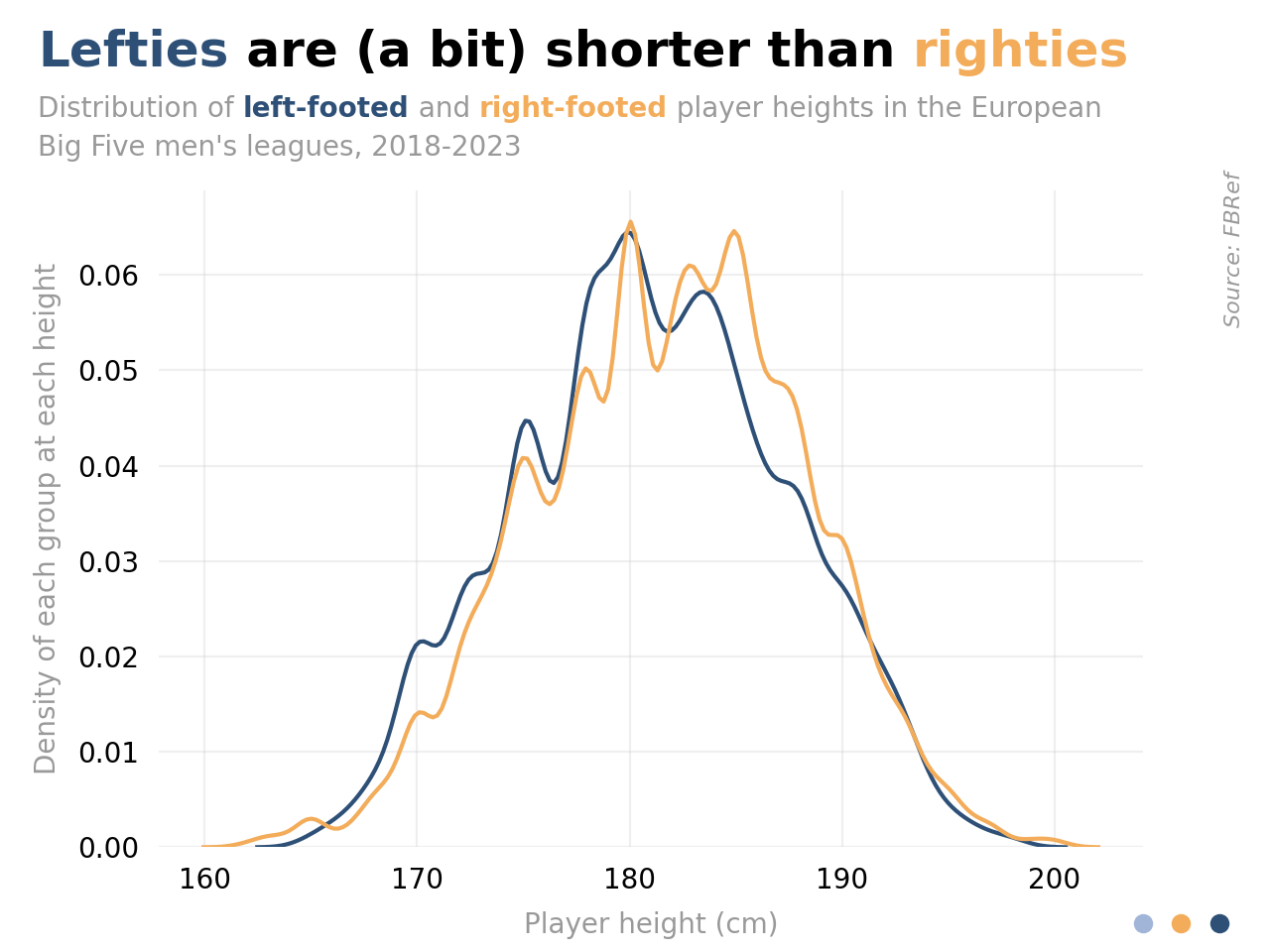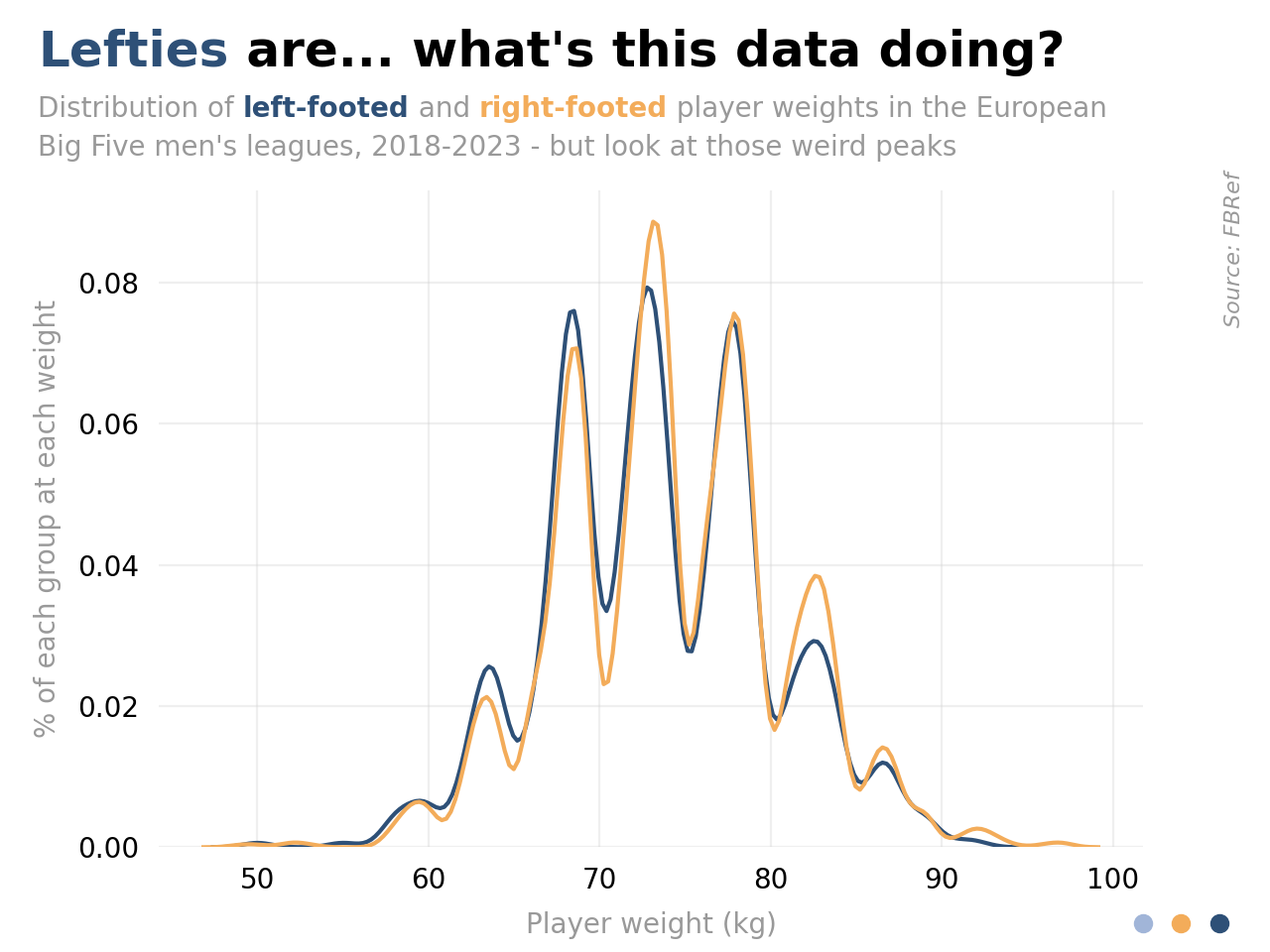Is it better to be a leftie?
Rafael Nadal hits a forehand with his left hand and signs his name with his right. How different would the honours list at Roland Garros look if his uncle Toni hadn't decided to train Rafa to hit with his 'weaker' hand as a child.*
*(in fact-checking I've discovered this is an urban myth and Rafael simply played the left-handed forehand better once he was old enough to start hitting balls with one hand)
Being left-handed in tennis, like cricket and baseball, is a bit like being above a certain height threshold in basketball - a rare physical trait that gives some in-game advantages.
I had an idle wondering recently whether the same might be true in football. The amount of articles written about the value of left-footed passing angles seems to have risen sharply in the past few years, a trajectory not seen since Q4 2020 Bitcoin. If you were the coach of a young kid, would it be valuable to train them as a left-footer? If you were at an academy, would you specifically look out for them, even if other parts of their game don't match up to their peers?
And then I realised I could actually probably look into this with data, and was therefore compelled to.
First, the question has to be refined into something there's data for, and I landed on two easy ways to approach it. One is simply whether there are more left-footers playing football than exist in the general population; the other is whether they're smaller on average (worse is not at all easy to judge) than their right-footed peers.
On the first count, – well, actually, let's just take a moment so that you can guess what the rate of left-footedness in the general population is.
Just take a punt.
Did you guess close to the approximate figure of around one in ten who are left-handed?
Estimates that I found online ranged from around that level (https://www.psychologytoday.com/gb/blog/the-asymmetric-brain/202009/large-study-reveals-how-many-people-are-left-footed) right up to 24% who are 'non-right-footed' (https://www.nature.com/articles/s41598-020-71478-w).
For the footballer data, I gathered from FBref (so, Opta data) players who:
- Are an outfielder
- Had played 1000+ more minutes
- In any of the Big Five men's European leagues
- In any single season in the past five years (i.e. a minimum bar of 1000 minutes in one season, not 200 in five)
Just over 27% of these (2800 total players) were left-footed, so it does seem like being a leftie is more common in elite professional men's football than it is out in the wild. Just. But let's count that as Count One: ✅.
On Count Two, 'can left-footed players get away with being scrawny', things were less clear. The ~2000 right-footers have a mean average height of 181.8cm and the ~740 left-footers come in at 181.1cm. The presence of a marginal difference is there in weight too, righties a touch heavier than lefties (maybe because of the height) at a mean average of 74.2kg to 73.5kg.

Now, this is a nerdy newsletter so we're going to have a nerdy note about this visualisation. I had to reduce the smoothing on this KDE plot because the default in the plotting software smoothed away the fact that the modal height for righties in the sample is 180cm. Do we think it's interesting that there's a peak, going against the general trend, bang on 180cm? Who can say. Who. Can. Say.
The weights also have clusters of values, although I'm not really sure what pattern they follow (not on round kg numbers but around every 5kg, which is about 11 lbs). The distribution, at the same level of smoothing, is very spiky.

So, Count Two: ❓. The weights don't interest me that much anyway - it made sense to take a look given that the data was there, but you can put on mass in a way you can't with height - but what if even these slight differences are 'fake' ones?
The positions where being left-footed seems to be the strongest tactical advantage are at left-back and inverted right-sided forward. It seems likely that the relationship between the value of height/weight vs footedness varies by position, and neither of these are positions where height matters a lot (unlike, say, centre-back). Maybe this is a confounding factor when we're looking at all outfielders together.
(I did consider digging into this position-specific question, but didn't feel confident in categorising the position strings that FBref gives players).
So, I'm sorry to the Uncle Tonis-of-myth of the world: if you want to give your young relatives the best chance of being an elite footballer it may not help them that much if you persuade them to take up being left-footed. Depends on your philosophy on marginal gains. But it was fun to take a quick look at.
Data notes postscript
- I excluded goalkeepers on this because I think they're a distinct enough skillset from outfielders, where height and hand-coordination is so much greater a factor than footedness
- I get that FBref/Opta data might be fakey (all the fellas are six foot eh), but I figure that it'll be fake-y in the same ways for both types of footedness
- I imagine that this will play out differently for different levels of football - it seems plausible to me that 1) there'll always be a minimum floor of lefties given that the disadvantages of a right-footer playing at left-back are so great 2) the advantage of being a leftie in build-up play matters more at levels where build-up play passing angles matter more